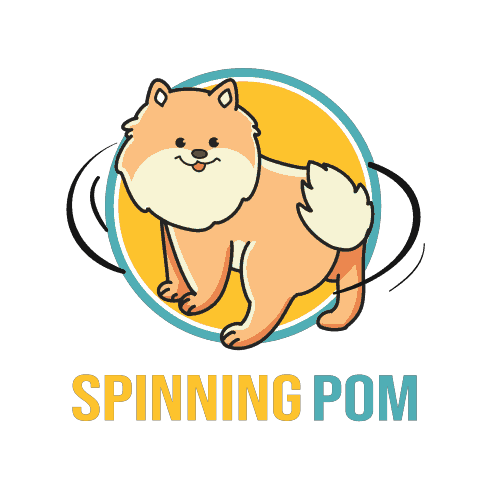One of the most unfortunate, but not rare, Pomeranian health problems is hyperadrenocorticism, commonly known as Cushing’s disease. Pomeranian Cushing’s disease is a result of excessively high and prolonged levels of cortisol, which is a hormone that’s release in Pomeranians when experiencing stress and anxiety. Sadly, these high levels of cortisol can be traced back to a developed tumor in your Pomeranian.
So, what are the most common Pomeranian of Cushing’s disease symptoms? The most common Pomeranian Cushing’s disease symptoms include increased thirst, increased urination, increased appetite, reduced activity, excessive panting, thinning skin, fragile skin, hair loss, frequent skin infections, or a large “potbelly”.
Just because your Pomeranian experiences one or many of these symptoms doesn’t necessarily mean they have Cushing’s disease. While you should certainly be concerned, you should know that Cushing’s disease is often not fatal and doesn’t significantly affect the length of your Pomeranian’s life.
As you probably thought, there’s a lot more to the Pomeranian Cushing’s disease story, which is exactly why I’m going to walk you through in more detail the symptoms, causes, and treatments of Pomeranian Cushing’s disease. If you’re concerned about your Pomeranian having this unfortunate disease, you’ll want to read on to learn more.
Pomeranian Cushing’s Disease Symptoms
Cushing’s disease in Pomeranians is one of the most unfortunate diseases your Pomeranian could experience in their lifetime, but there’s no need to panic if they’re diagnosed with it. Most Pomeranians who are diagnosed with Cushing’s disease are in their adult years with the age ranging between 1-8 years.
While young Pomeranians have been diagnosed with Cushing’s disease, the vast majority won’t show the following symptoms until their in their adult years:
- Increase in thirst (polydipsia)
- Increase in urination (polyuria)
- Involuntary urination
- Increase in hunger
- Excessive panting
- Abdomen shaped like a potbelly
- Obesity
- Excess fat surrounding their neck and shoulders
- Hair loss
- Lethargic
- Loss of muscle mass
- Infertility
- Thin skin
- Easily damaged skin
- Easily bruised
If your Pomeranian is experience one or a couple of these, it’s likely your Pomeranian doesn’t have Cushing’s disease. However, if you see a handful of these symptoms in your Pomeranian and they’re above the age of one, you’ll definitely want to contact your local veterinarian immediately.
Apart from these Pomeranian Cushing’s disease symptoms being present, there are still tests that your veterinarian can perform to find out whether they have Cushing’s disease or not. A quick and easy test that your veterinarian will implement is a blood test, which can answer many questions about the health of your Pomeranian.
The most common test for diagnosing Cushing’s disease in dogs is the low-dose dexamethasone suppression test (aka LDDST). In simple terms, this blood test is a way to properly measure the standard cortisol level experienced in your Pomeranian. After injecting a low-dose of dexamethasone into your Pomeranian, within 4-8 hours you and your vet will know whether or not your Pomeranian’s cortisol levels are normal or too high.
While the LDDST is the most common and effective way of diagnosing Cushing’s disease in your Pomeranian, it’s also possible through a urinary test called urine cortisol-to-creatinine ratio. Results that show a high urine cortisol-to-creatinine ratio can help vets pinpoint whether or not your Pomeranian has Cushing’s disease.
If your vet is uncertain about any of the previous test results, they can also detect Pomeranian Cushing’s disease by running what’s known as an ACTH stimulation test as well as an abdominal ultrasound. These tests can help pinpoint where exactly the disease in your Pomeranian is coming from, be it from a tumor in your Pomeranian’s adrenal or pituitary glands, as well as whether the tumor is benign (not spreading) or malignant (spreading).
What Causes Cushing’s Disease in Pomeranians?
Knowing the most common symptoms and how to detect whether your Pomeranian has Cushing’s disease is vitally important. However, it’s also important to know where it comes from so you have a better understanding of the disease and how it came to be present in your Pomeranian.
As I mentioned before, Cushing’s disease (or hyperadrenocorticism) is a naturally occurring disease resulting in high and prolonged levels of cortisol circulating through your Pomeranian. Cortisol is an extremely important hormone found in dogs, cats, and even humans, and is commonly known as a “stress hormone” that’s triggered in “fight-or-flight” and other scenarios.
As a common hormone in Pomeranians and dogs alike, cortisol is secreted in your Pomeranian’s body from glands, which are several among many glands that are a part of your Pomeranian’s endocrine system. When cortisol is operating normally at expected levels, it helps your Pomeranian deal with appropriate responses to stress helps regulate their immune system. Too much cortisol can weaken the immune system, leaving your Pomeranian susceptible to various diseases and infections.
Since Cushing’s disease is a result of abnormal levels of cortisol pumping throughout your Pomeranian’s body, they’re effectively in a state of stress and anxiety for no reason other than a hormonal imbalance in their endocrine system, more specifically either in their pituitary gland or adrenal glands.
About 80-85% of all Pomeranians and other dogs diagnosed with Cushing’s disease are found to have high levels of cortisol due to a tumor located in their pituitary gland, which is located at the base of your Pomeranian’s brain and is about the size of a pea. The pituitary gland is commonly referred to as the “master gland” since it produces many hormones that travel throughout the body.
As you might have already guessed, the other 15-20% of all Pomeranians and other dogs diagnosed with Cushing’s disease are found to have a tumor located in their adrenal glands, which are located above your Pomeranian’s kidneys. Depending on the severity of your Pomeranian’s diagnosis, there may be a tumor on top of both kidneys. The adrenal glands are known for producing various hormones, more notably adrenaline, aldosterone, and cortisol.
The tumors that form around one of these two sets of glands are most often found to be benign, which means the tumor is stable and not spreading. However, it can be the case that the tumor is malignant (or spreading), resulting in a potentially fatal outcome. Fortunately, it’s quite rare for tumors that produce Cushing’s disease in Pomeranians and dogs to be malignant, so that’s good news!
Cushing’s disease in Pomeranians and other dogs is virtually always the result of a natural occurrence that’s, unfortunately, unavoidable for some. However, it can also be the result of excessive use of certain medications that treat common health problems in dogs, which means you should double check with your vet before administering any new medications for your Pomeranian.
Prescription corticosteroid medications used at high doses for a long period of time have been found to cause Cushing’s disease in dogs, which is very unfortunate. These medications usually treat common health problems including allergies, immune disorders, and even cancer. These corticosteroid medications are quite effective at reducing inflammation and as a way of leveling out low cortisone levels in dogs. Thankfully, “medication-caused” Cushing’s disease can be reversible by either reducing or completely stopping the use of these medications.
Treating Cushing’s Disease in Pomeranians
Being able to understand Pomeranian Cushing’s disease symptoms, diagnoses, and causes is incredibly important in pinpointing the disease and its origins, but that’s just the beginning. Moving forward by properly treating your Pomeranian’s Cushing’s disease is the very next step, and luckily there are several ways to go about it.
Oral Medication
By far the most common and least intrusive ways of treating Cushing’s disease in Pomeranians is through the use of prescription oral medications. By simply giving your Pomeranian a tablet, chew, or drop of their veterinary-prescribed medication, you’ll be able to keep their symptoms at bay.
When treating Cushing’s disease in Pomeranians through the use of oral medications, it’s vitally important that you take your Pomeranian to the vet on a regular basis so they can get their blood tested. Depending on the results of these tests, your veterinarian may adjust the dosage of your Pomeranian’s medication.
By far the most popular medication for treating Cushing’s disease in dogs is Vetoryl, which is able to treat both pituitary- and adrenal-dependent Cushing’s disease in Pomeranians. By getting your Pomeranian a prescription in Vetoryl, they’ll be able to live a life with reduced levels of cortisol produced by their glands.
Unfortunately, there are some common side effects when using Vetoryl, including reduced appetite, vomiting, lethargy, diarrhea, and weakness. Less common side effects include bloody diarrhea, collapse, sodium and potassium imbalance, destruction of the adrenal gland, and even death. None of that sounds good at all.
As long as your veterinarian is able to regularly and accurately read your Pomeranian’s blood, cortisol, and overall health levels and match them with the right dosage of mediation, your Pomeranian can live a long and happy life free from the debilitating symptoms of Cushing’s disease. As long as you take your Pomeranian in when you’re supposed to, keep an eye on your Pomeranian’s health, and give them the medication correctly, everything should be just fine.
Radiation Therapy
The only way to truly “cure” any disease that’s caused by a tumor is to completely remove it, which includes killing it with radiation. While the use of radiation therapy on your Pomeranian might seem like overkill, their grade of Cushing’s disease and whether their tumors are benign or malignant will likely determine the level of severity.
Through the use of radiation therapy, you can effectively zap away the tumor that’s present in your Pomeranian. While this will certainly bring on a number of side effects that aren’t pretty, your Pomeranian could come out even strong if the tumor is completely removed, resulting in your Pomeranian’s Cushing’s disease to cease to exist.
Surgery
Another way to completely remove the tumors that cause Cushing’s disease in Pomeranians is through invasive surgery. Similar to radiation therapy, the idea is to completely remove the tumor so it’s no longer able to cause an excess in cortisol circulating throughout your Pomeranian’s body.
If your Pomeranian’s tumor is benign and hasn’t spread outside of the pituitary gland or adrenal gland, then surgery could be a great solution. Of course, any form of surgery has risk involved, elongated recovery times, and high financial costs. There’s also no guarantee the tumor won’t grow back, but it might be worth removing it either way.
Natural Supplements
Pomeranians that are diagnosed with Cushing’s disease are not as uncommon among the Pomeranian community and are often diagnosed with a pituitary-dependant, benign (not spreading) tumor. For that reason, it’s quite often the case that Pomeranian parents will avoid any risk health side effects related to radiation therapy and surgery, and instead focus on simply reducing their Pomeranian’s symptoms through the use of prescription oral medications as well as natural supplements.
While oral medications prescribed by your veterinarian can be highly effective, many people also choose to opt for using supplements specifically aimed at helping reduce stress, anxiety, and, thus, cortisol levels in their Pomeranians. Whether you choose to use calming supplements with or without oral medications, there are certainly plenty of supplement options for you to choose from, especially if you want to avoid any nasty side effects from oral medications.
Best Adrenal Support Supplements for Pomeranians with Cushing’s Disease
Putting your Pomeranian through radiation therapy and surgery when treating Cushing’s disease in Pomeranians can cause more problems than they solve. And the use of some of the oral medications prescribed by veterinarians can come with some awful side effects which can be easily avoided through the use of effective adrenal support supplements
For these reasons, I want to share with you some of the adrenal support supplements that have helped the Pomeranian and dog community as a whole to effectively treat the symptoms of their dogs’ Cushing’s disease.
Pet Wellbeing Adrenal Harmony Natural Support Drops
Some of the best pet supplements out there come from Pet Wellbeing and that especially goes for the Pet Wellbeing Adrenal Harmony Natural Support Drops (link to read reviews on Amazon). Apart from the strong and well-trusted brand that is Pet Wellbeing, these drops are specifically designed to tackle your Pomeranian’s adrenal dysfunction and cortisol imbalance.
With this holistic, vet-formulated supplement you’ll be well on your way to treating the symptoms your Pomeranian’s experience under Cushing’s disease. Through the use of purity tested, organic ingredients, these adrenal support drops are shown to support normal thirst, urination, weight, appetite, hair growth, and skin strength. You can’t go wrong with Pet Wellbeing, which is why they offer a 100% money back guarantee!
PetAlive Cushex Drops Adrenal Gland Balance Supplement
There aren’t too many top brands that produce an effective supplement for treating the common symptoms found in Pomeranians with Cushing’s disease. However, PetAlive Cushex Drops Adrenal Gland Balance Supplement (link to read reviews on Amazon) are at the top of the list based on their overwhelming customer satisfaction and effective product.
These adrenal support drops by PetAlive are exactly what your Pomeranian needs for treating their Cushing’s disease symptoms. Through their scientifically selected natural herbs free from chemicals and preservatives, your Pomeranian will experience an improved endocrine system, increased energy, optimal skin health, and much more. These drops by PetAlive have become increasingly popular among the community, so you should definitely check them out.
Fur Goodness Sake Adrenal Support Cushing’s Treatment for Dogs
Another amazing brand that creates some of the best dog supplements out there is Fur Goodness Sake (I love their name), which is why they’re on the list of the best adrenal support supplements for Pomeranians with Cushing’s disease. If you haven’t taken a look at the Adrenal Support Cushing’s Treatment for Dogs by Fur Goodness Sake (link to read reviews on Amazon), go take a look when you get a chance.
These adrenal support supplement drops are highly effective at maintaining normal kidney and adrenal function in your Pomeranian through the use of a proper mix of powerful herbal extracts. Their clinically proven herms help to gently and safely restore healthy adrenal function while reducing the unpleasant symptoms experienced by your Pomeranian. This 100% herbal remedy will help your Pomeranian get back to their normal self if they’re suffering from Cushing’s disease!
Green Vet Premium Adrenal Support Cushing’s Drops for Dogs
One of the few adrenal support supplements no-doubt has to go to the Premium Adrenal Support Cushing’s Drops for Dogs by Green Vet (link to read reviews on Amazon). By producing a healthy and natural kidney and adrenal support supplement, they’ve proven they can improve upon the symptoms of your Pomeranian’s Cushing’s disease.
This veterinarian recommended adrenal support Cushing’s supplement is packed with organically grown ingredients that have been third-party tested for 100% purity. Their unique blend of organic herbs has shown to restore balance in the endocrine system of many dogs, resulting in a reduction of the most common symptoms found in Pomeranians with Cushing’s disease. It’s also 100% made in the USA without the use of GMOs, herbicide, or chemical fertilizers!









